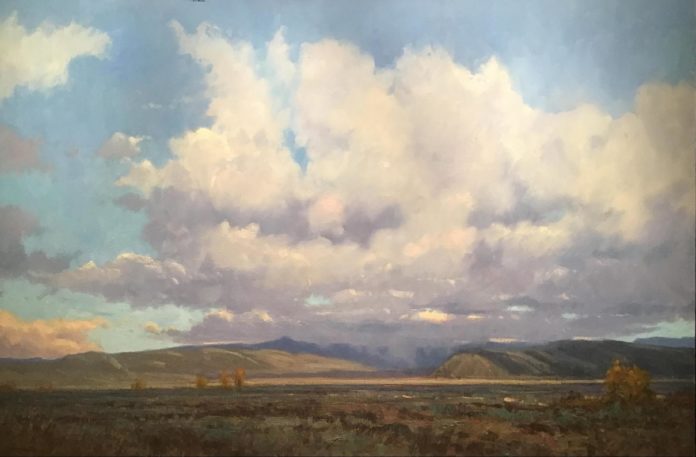While recently working on a large studio painting, I was reminded of the fact that designing is a lot like a game of strategy. Chess comes to mind. There is a necessity here to be ready to re-synthesize new information as it presents itself in a rapidly changing design. With every brushstroke comes a decision about how it affects the overall work.
Each new mark changes the relationships in the painting in one way or another, no matter how small its influence. Some relationships are more important than others and because of this, design choices must be made carefully in these areas. One thing is for sure, though; each new mark on the canvas is one of four possible things: It is either wrong, too little, too much, or just right. Unlike a game, such as chess, the reasons for this are not always strictly quantifiable, but are more felt. When it’s right, it’s right, and you just know it!
One of the challenges when working on a huge painting is the amount of time it takes just to cover the canvas! As a result, a really big painting can be as physically exhausting as it is mentally challenging. The more you work on it, sometimes late into the afternoon or evening, the less able you may become in making sound design choices! These choices, most likely would have been less troublesome in the morning when you were fresh, which is certainly something to consider. So I suggest taking breaks from the action from time to time, and even knocking off for the day when you feel yourself on the losing end of the design strategy game.
I was recently introduced to a concept called the OODA Loop, while listening to an online lecture by famed Steely Dan/Doobie Brothers guitarist and now military analyst, Jeff “Skunk” Baxter. He brought up this concept, which stands for Observe, Orient, Decide, and Act. He spoke of how it applies to many situations in music and in military actions, where you have to be quick on your feet in an ever-changing environment. This really struck a chord with me, regarding its applicability to design. Along with the other situations mentioned, design is an ever-shifting environment where the battle can be won or lost starting with one errant brushstroke, which can lead to a thousand other artistic missteps.
The key component in the OODA Loop is the orientation phase, which is based on observation, but also a whole lot more! I suppose that if observation were the only component that went into our orientation, most of our paintings would look eerily similar! Our ability to accurately observe nature is either spot on, or tainted to some degree by our skewed understanding of the way light works. Other things play a part as well; one’s fatigue level, true or false concepts, past experiences, personality, and a ton of other influences. All of these can and do play a part in the making of successful decisions which precede execution.
In order to be more effective in our design choices, we need to work on our orientation all the time. Tweaking concepts here and there and always staying open to new ideas, which may supplant old ones, is a must if we want to be on our design game.
A lot of things can stand in the way of an orientation adjustment. Things like ego, inertia, jealousy, pride, and fear can all be growth inhibitors to one’s success in designing paintings. Luckily, no human lives are at stake in these art-related mishaps, but advancement in the capacity to design is no small matter for an artist either! Personal growth as an artist is as important as sunlight is to a garden. Without it, we can wither and dry up creatively!
I always find it interesting how knowledge in one area may have a million possibilities for applications in other seemingly unrelated disciplines. Thinking outside the box and looking for these links is one way someone like Jeff “Skunk” Baxter has been able to stay sharp, which benefits not only him but others as well.
Here’s hoping we all stay on our game when designing!
Please feel free to comment on this article and add your perspective to the challenges of creating good designs.
Visit EricRhoads.com to find out all the amazing opportunities for artists through Streamline Publishing, including:
– Online art conferences such as Plein Air Live
– New video workshops for artists
– Incredible art retreats
– Educational and fun art conventions, and much more.
> Subscribe to Plein Air Today, a free newsletter for artists
> Subscribe to PleinAir Magazine so you never miss an issue






Observe, Orient, Decide, and Act (OODA loop) seems to be good test for each stroke and good reminder to make each brush stroke work with everything else in the painting. I always struggle with control of the painting process. Thanks for your innovative reminder.
Thanks Chuck!
The concept of OODA is a great tool for helping multi-disciplines, especially artists, to evaluate the choices made in expressing their interpretation of the environment and their individual creativity.
Thank you for sharing your insights!
Thanks for your insightful comment Ann Marie!